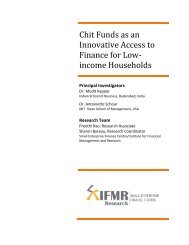Government of India Volume I: Analysis and Recommendations
Government of India Volume I: Analysis and Recommendations
Government of India Volume I: Analysis and Recommendations
You also want an ePaper? Increase the reach of your titles
YUMPU automatically turns print PDFs into web optimized ePapers that Google loves.
Table <strong>of</strong> <strong>Recommendations</strong> 6.4 Regulation <strong>of</strong> entry<br />
The regulator will have the following powers in connection with restricting entry:<br />
MICRO-PRUDENTIAL REGULATION<br />
1. Notifying pre-conditions for authorisation to carry on regulated activities;<br />
2. Authorising to carry on regulated activities, which may include a process <strong>of</strong> automatic authorisation; <strong>and</strong><br />
3. Approving changes in the controlling interest <strong>of</strong> regulated persons.<br />
If new firms can be created, existing firms can launch new products or services, <strong>and</strong><br />
entirely new business models can come about, the environment will be competitive <strong>and</strong><br />
dynamic. The pursuit <strong>of</strong> these objectives presents two puzzles: the legal framework<br />
should allow only reliable <strong>and</strong> competent persons to deal with financial consumers, <strong>and</strong><br />
lack <strong>of</strong> existing regulations on a particular area should not hold back the emergence <strong>of</strong><br />
new business models.<br />
The Commission, therefore, recommends a balanced approach, which is enshrined<br />
in the draft Code.<br />
1. Requirement for authorisation: Any person who seeks to carry out a financial service<br />
for the first time will need to be authorised by the regulator. This will not apply<br />
to a new product or service launched by existing financial service providers, if<br />
the person is already authorised for that line <strong>of</strong> business. All new products can be<br />
launched after following the file <strong>and</strong> use process.<br />
2. Exemption: Representatives <strong>of</strong> authorised financial service providers need not seek<br />
authorisation for the services for their principal has been given authorisation, as<br />
long as the representative is only carrying out the activity with regards to those services<br />
on behalf <strong>of</strong> the principal. Through regulations, the regulator will have the<br />
power to exempt, from the authorisation process, certain agencies <strong>of</strong> the government.<br />
The intent here is to exempt only those agencies that have a unique character,<br />
such as EPFO. This power should only be used as an exception, <strong>and</strong> does not<br />
mean that other regulations will not apply to an agency exempt from the authorisation<br />
process.<br />
3. Authorisation process: The manner <strong>and</strong> process <strong>of</strong> obtaining authorisation for financial<br />
services will vary depending on the type <strong>of</strong> activity that is proposed to be<br />
carried out. A comprehensive authorisation process will apply to persons who want<br />
to carry out regulated activities which are to be micro-prudentially regulated with<br />
high intensity.<br />
The need to promote innovation in the <strong>India</strong>n financial system has been embedded<br />
thus: where a person proposes to carry out a financial service that is not a regulated<br />
activity, a simplified authorisation process will be applicable. Here, the regulator<br />
has the flexibility to specify that the authorisation requirement may be satisfied<br />
through an automatic process.<br />
In either case, whether an activity is regulated or non-regulated, the authorisation<br />
process will not allow the regulator to refuse authorisation merely on grounds that<br />
the regulator does not have in place appropriate regulations to govern the proposed<br />
activity.<br />
6.4.2. Regulation <strong>of</strong> risk-taking<br />
This category <strong>of</strong> powers will empower the regulator to prescribe ways in which the regulated<br />
persons can avoid or reduce the risks they take (see Table 6.5). Regulator may<br />
impose restrictions on how the regulated persons invests the funds - their own funds <strong>and</strong><br />
those <strong>of</strong> the consumers. In some cases, they may also impose restrictions on claims that<br />
may be placed from the regulated person’s over business on consumers’ funds. Regulator<br />
may also require adherence to certain business processes that reduce risks to the<br />
60 FINANCIAL SECTOR LEGISLATIVE REFORMS COMMISSION



